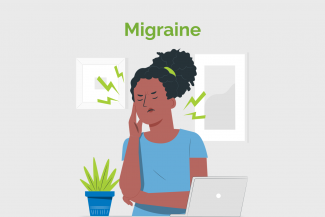Migraine is a chronic type of headache that occurs in episodes and affects the day to day activities of an individual. It usually affects one side of the head. Between migraine episodes, the patient is absolutely free of pain. Migraine is the most common neurological condition in the developed world.

Causes of Migraine
Causes are multifactoral with various genetic and environmental factors playing important roles. The patient may have a history of migraine in the family. Mutations of the gene in chromosome 1 and 19 are responsible for positive family history.
Disturbances in the release of certain brain chemicals called serotonin and dopamine may also cause migraine.
Migraine has two parts: 1) the aura and 2) the headache. (Symptoms of aura are mentioned below.) Cerebral blood vessels initially contract (causing decreased blood flow) and then dilate, starting in the occipital lobe region at the back of brain. The visual cortex at the occipital region is affected and is responsible for visual changes called aura, followed by headache.
Triggers and risk factors for a migraine:
- Dietary factors like Monosodium glutamate, red wine, chocolate
- Lifestyle factors, like alcohol
- Psychological factors, like stress, anxiety, depression
- Tiredness
- Jet lag
- Bright flashing light
- Abnormal sleep pattern
- Pungent odour
- Hormonal changes - 1st trimester of pregnancy, menstruation
- Weather change
- High altitude
Changed
30/Mar/2025
Community
Condition
















